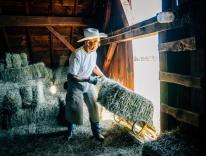
At last fall’s Synod on the Family, Archbishop Paul-André Durocher of Quebec asked that the ordination of women as deacons be considered. The suggestion didn’t seem to go anywhere. More recently, however, when a gathering of nine hundred heads of women’s religious communities from around the world (the International Union of Superiors General) raised this question again in May, Pope Francis was interested. He said he would call together an official commission to clarify the question of the historical role of women deacons. I was pleasantly surprised.
It was not long, however, before doubts set in. Hadn’t such a study already been done, with zero result? And the pope’s idea of asking the Congregation for the Doctrine of the Faith (CDF) to inform him of the state of the question—wasn’t that the kiss of death? After all, the head of the CDF, Cardinal Gerhard Müller, is well known for his opposition to women in the diaconate. Was this just a way to avoid a tough question—form a committee?
As it turns out, the International Theological Commission (ITC) has done two historical-theological studies of women in the diaconate. One, begun in 1992 and completed in 1997, never saw the light of day. The prefect of the CDF, then-Cardinal Joseph Ratzinger, refused to sign it, presumably because it took a positive view of ordaining women deacons. A second, much longer study, which Cardinal Müller helped to write, was published in 2002. It concluded that male and female deacons in history are not “purely and simply equivalent” (deaconesses were inferior) and the question of what to do today is a matter for discernment by church authority.
This latter study, although it leaves the question open, is clearly biased against the possibility of ordaining women to the diaconate. For example, the New Testament evidence is reviewed—including much about the Jerusalem “seven,” who assisted the Apostles but are never called deacons—without a single mention of Phoebe the deacon in St. Paul’s letter to the Romans. She turns up briefly, many pages later, under the subheading “Deaconesses,” but is dismissed.
Poor Phoebe. The only person in the New Testament to have actually been called a deacon, and she is brushed aside on linguistic grounds: “Although the masculine form of diakonos is used here, it cannot therefore be concluded that the word is being used to designate the specific function of a ‘deacon’; firstly because in this context diakonos still signifies servant in a very general sense, and secondly because the word ‘servant’ is not given a feminine suffix but preceded by a feminine article.” Got that? For good measure, we are reminded at the end of the paragraph that in 1 Corinthians St. Paul also refers to the “diakonoi” of the devil.
Speaking of the devil, there is no acknowledgement in the study that misogyny may have played a role in the suppression of women’s ministries. The notion that a renewal of the practice of women in diaconal ministry today might actually right a wrong, or quicken the Spirit, or enrich the ministry, seems never to have occurred to the study’s authors, or if it did they didn’t mention it. I find that sad. Reading the history requires more clear-sightedness, courage, and imagination than we have seen to date in Rome.
When you come right down to it, advocacy for the ordination of women deacons is a conservative position. On the one hand, it brings some of the charisms exercised by women in the church into a structured relationship with the bishop, and thus under his (presumably unifying) influence. On the other, it contributes to the good name and effective witness of the church as an institution by the orderly channeling of women’s energies into its “regular” ministries rather than ad hoc and “irregular” ones.
Ironically, any gains that might be made by the recognition and routinization of the charisms of women through ordination are outweighed in the minds of some male clerics by the danger of “clericalizing women.” These concerns are overblown. Clergy who obsess about the dangers of clericalism in women are projecting their own sins and selling short women’s capacity for virtue.
If Pope Francis convenes a new commission, and perhaps even places a few women on it (none of the authors of the two preceding studies were female), will they come up with different results? They might. There has been new research on the subject of women deacons within Roman Catholicism by scholars such as Phyllis Zagano, Gary Macy, Bill Ditewig, and John Collins, and some of the historical sources on which the 2002 ITC study relies have been reevaluated. There is also conversation in Orthodox circles about the “rejuvenation” of the ministry of women deacons. Here one might mention the scholarly work of Kyriaki Karidoyanes FitzGerald, Saint Catherine’s Vision (a pan-Orthodox theological fellowship), and the St. Phoebe Center for the History of the Deaconess.
Time will tell. In the meanwhile, perhaps we should ask Saint Phoebe to pray for us. Though she would later be despised for the lack of a feminine suffix, she did manage to do the work.
